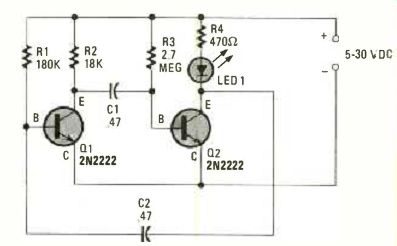
This flashing light tells you that it is time to turn off the power switch!
BY EVERT FRUITMAN
HOW MANY TIMES HAVE YOU REACHED FOR A PIECE OF battery- operated equipment only to be disappointed upon finding the batteries drained, because someone had forgotten to turn it off? Some kind of pilot light might have saved the day, and the batteries! But a pilot light wasn't used because of the current it consumes. Even a light emitting diode (LED) with a current- limiting resistor, Fig. 1, represents a moderate drain on the battery when compared to the circuit's normal battery load.
Cheer up! The Extra-Low-Power Pilot Light does just what its name implies. It draws very little power from a battery and its periodic flicker serves as a reminder for the user to turn off the portable equipment. Its wide range of operating voltage, (5-30 DC), and small size make it versatile enough to be added to almost any project that might require its use. Of course, it could be added to new equipment too! There is, or was, a LED chip on the market made to do almost the same thing. I ran into three little problems with it. It has a limited voltage range; it was expensive, and it wasn't always available. The first problem was solved with a Zener diode in series with the power- supply line. The last problem was solved with the circuit shown in Fig. 2. The middle problem remained the same unless you salvaged parts from the junkbox-then the price is right.

FIG. 1--HERE'S A TYPICAL light- emitting diode (LED) circuit that usually
draws approximately 20 milli-Amperes. The LED light is on continuously when
power is supplied, causing a severe battery drain when left running over
night. Often the pilot light consumes more power than the equipment itself
would when left on after being used. What a way for a battery to go!
The circuit, Fig. 2, consists of a simple cross-coupled free-running oscillator with an LED in between the battery and the collector of Q2. As the transistors, Q1 and Q2, are alternately switched on and off, so is LED1. The values of resistance and capacitance are chosen so that minimum current is drawn in the off mode, and LED 1 is off longer than it is on during each cycle. An added feature of that design is that electrolytic capacitors are not needed. The values for the resistors specified in the Parts List express a wide range of ohms because the circuit is not too critical, and the experimenter may select those values he currently possesses (different from those in Fig. 2) so that project cost may be kept very low. Also, the chances are that you may be able to assemble the project this very evening from parts presently in your junkbox.
Typical current drain using a 10-volt power supply runs from less than one-half mA (.5 mA) in the off mode to about 14 mA during the on mode, or light burst. At 5-volts DC the drain is a quarter of a mA (.25 mA) and 3 mA, respectively.
The higher the voltage, the faster the Extra-Low-Power Pilot Light blinks. That friendly colorful wink from LED1 you pick the color) could be enough of a reminder to save you the loss of perfectly good batteries, and the use of valuable equipment when you need them most.

FIG. 2--THE EXTRA-LOW-POWER PILOT-LIGHT circuit is nothing more than a free-running
multivibrator designed to keep power consumption down-way down! Values are
not critical, and most any NPN transistor can be used in this project.
PARTS LIST FOR EXTRA-LOW-POWER PILOT LIGHT
C1, C2--.47-uF. 50-WVDC disc or tubular capacitor
LED1--Light-emitting diode, your choice of color
Q1, Q2--2N3904, 2N2222, ECG123, or most any suitable replacement types of NPN, general-purpose, low-power transistor
R1--180,000-ohm, 1/4-watt composition resistor
R2--18,000 to 22,000-ohm, 1/4-watt composition resistor
R3--1.7 to 4.7-Megohm, 1/4-watt composition resistor
R4--470 to 620-ohm, 1/4-watt composition resistor
Note: Resistors may be either 20%. 10% or 5% tolerance.
Perfboard or printed-circuit board materials, wire, cement, solder, hardware, etc.
Adapted from: Radio-Electronics--Special Projects (Summer 1983, #7)
= = = =
Radio-Electronics--Special Projects (USA print magazine)